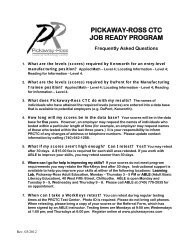Commons
Conceptual Physics - elearning-phys
Conceptual Physics - elearning-phys
- No tags were found...
You also want an ePaper? Increase the reach of your titles
YUMPU automatically turns print PDFs into web optimized ePapers that Google loves.
Sound wavesThe phenomenon of sound is easily found to have all the characteristicswe expect from a wave phenomenon:• Sound waves obey superposition. Sounds do not knock othersounds out of the way when they collide, and we can hear morethan one sound at once if they both reach our ear simultaneously.• The medium does not move with the sound. Even standingin front of a titanic speaker playing earsplitting music, we donot feel the slightest breeze.• The velocity of sound depends on the medium. Sound travelsfaster in helium than in air, and faster in water than in helium.Putting more energy into the wave makes it more intense, notfaster. For example, you can easily detect an echo when youclap your hands a short distance from a large, flat wall, andthe delay of the echo is no shorter for a louder clap.Although not all waves have a speed that is independent of theshape of the wave, and this property therefore is irrelevant to ourcollection of evidence that sound is a wave phenomenon, sound doesnevertheless have this property. For instance, the music in a largeconcert hall or stadium may take on the order of a second to reachsomeone seated in the nosebleed section, but we do not notice orcare, because the delay is the same for every sound. Bass, drums,and vocals all head outward from the stage at 340 m/s, regardlessof their differing wave shapes.If sound has all the properties we expect from a wave, then whattype of wave is it? It must be a vibration of a physical medium suchas air, since the speed of sound is different in different media, suchas helium or water. Further evidence is that we don’t receive soundsignals that have come to our planet through outer space. The roarsand whooshes of Hollywood’s space ships are fun, but scientificallywrong. 1We can also tell that sound waves consist of compressions andexpansions, rather than sideways vibrations like the shimmying of asnake. Only compressional vibrations would be able to cause your1 Outer space is not a perfect vacuum, so it is possible for sounds waves totravel through it. However, if we want to create a sound wave, we typically doit by creating vibrations of a physical object, such as the sounding board of aguitar, the reed of a saxophone, or a speaker cone. The lower the density of thesurrounding medium, the less efficiently the energy can be converted into soundand carried away. An isolated tuning fork, left to vibrate in interstellar space,would dissipate the energy of its vibration into internal heat at a rate manyorders of magnitude greater than the rate of sound emission into the nearlyperfect vacuum around it.Section 8.3 Sound and Light Waves 171



